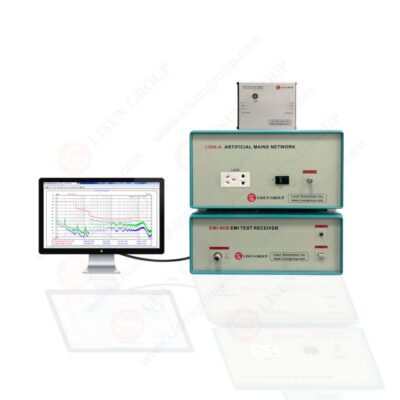

Introduction
Electromagnetic Interference (EMI) is a significant concern for the performance and reliability of electronic devices. EMI measurements are crucial to ensuring that devices comply with international standards for emissions and electromagnetic compatibility (EMC). This article delves into the role of the LISUN EMI-9KB Test Receiver, a comprehensive solution for conducting EMI measurements from 9kHz to 300MHz, in various applications like lighting systems, household appliances, and electric tools. We will explore its functionality, testing processes, and some relevant technical data, providing insight into its key role in addressing EMI challenges.
EMI and Its Importance
Electromagnetic interference occurs when electromagnetic waves from a source disrupt the normal operation of electronic devices. EMI can originate from internal components or external sources, affecting a device’s functionality, communication, and even safety. Therefore, regulatory standards such as CISPR and FCC mandate specific emission limits for electronic products, which must be tested using equipment like the LISUN EMI-9KB Test Receiver. Ensuring compliance is critical for product certification and market entry.
LISUN EMI-9KB Test Receiver Overview
The LISUN EMI-9KB is designed to handle both conducted and radiated emissions testing. With a frequency range of 9kHz to 300MHz, this device offers robust solutions for measuring emissions and identifying sources of EMI. It is equipped with features such as:
• Detection Modes: Peak (PK), Quasi-Peak (QP), and Average (AV), providing flexibility in evaluating different emission characteristics.
• Frequency Stability: 1×10⁻⁶, ensuring precise and repeatable measurements.
• Resolution: As low as 30Hz in the 9kHz to 150kHz range, offering high accuracy for low-frequency measurements.
• Sweep Bandwidth: Ranges from 200Hz to 120kHz, suitable for varying test conditions.
• Artificial Network Power (LISN): Provides consistent impedance between the device under test (DUT) and the power supply, ensuring accurate EMI measurements.
Figure: EMI Test Receiver EMI-9KB
Conducted Emissions Testing
Conducted emissions testing focuses on electromagnetic interference transmitted through power lines or other connections. Using the LISUN EMI-9KB system along with a Line Impedance Stabilization Network (LISN), this type of testing measures the unwanted radiofrequency emissions conducted from the DUT to the external environment.
Table 1 illustrates sample test results for a lighting fixture under conducted emissions testing at different frequency bands:
Frequency (MHz)
Peak Level (dBμV)
Quasi-Peak Level (dBμV)
Average Level (dBμV)
0.15
49.2
44.8
40.5
0.5
53.1
48.6
42.7
1
60
55.2
50.3
These readings help identify the frequency ranges where interference is most problematic, enabling manufacturers to make necessary design modifications.
Radiated Emissions Testing
In radiated emissions testing, the focus shifts to electromagnetic waves emitted from the device through the air. The EMI-9KB system, when combined with antennas and shielding enclosures, measures these emissions across the specified frequency range (9kHz–300MHz). This is critical in environments where multiple devices operate simultaneously, such as industrial setups or residential areas.
A test setup involves placing the DUT in a shielded room, using coupling/decoupling networks (CDNE) like CDNE-M316 to simulate conditions where radiation disturbances are common. The EMI-9KB is capable of detecting minute emission levels, ensuring that devices meet radiated emission standards set by regulatory bodies such as CISPR 15 and FCC Part 15.
Test Environment and Setup
For precise EMI measurements, environmental conditions and test setups are crucial. A test room typically measures around 3m by 3m by 2.5m and should minimize external interference, using shielding cabinets like the LISUN SDR-2000B. Copper grounding plates further stabilize the test environment, reducing stray emissions that could affect readings.
Comparison with EMI-9KA and EMI-9KC Receivers
LISUN offers a range of EMI receivers, including the EMI-9KA (9kHz–30MHz) and EMI-9KC (9kHz–1GHz), suitable for different test requirements. While the EMI-9KB focuses on emissions up to 300MHz, the EMI-9KC extends the range to 1GHz, covering a broader spectrum. This flexibility allows the EMI-9KB to be used in diverse applications, such as measuring interference in lighting products, consumer electronics, and communication devices.
Conclusion
The LISUN EMI-9KB Test Receiver is an essential tool for accurate and reliable EMI measurements across various industries. With its high-resolution detection, frequency stability, and comprehensive testing capabilities, it provides manufacturers with the necessary insights to mitigate EMI and comply with international standards. By ensuring that devices meet stringent EMC regulations, manufacturers can improve product performance, reduce interference, and enhance safety.
Table 2: Key Specifications of the LISUN EMI-9KB
Feature
Specification
Frequency Range
9kHz–300MHz
Frequency Resolution
30Hz (9kHz–150kHz), 1kHz (150kHz–30MHz), 5kHz (30MHz–300MHz)
Detection Modes
Peak, Quasi-Peak, Average
Frequency Stability
1×10⁻⁶
Test Tolerance
±2 dB
Sweep Bandwidth
200Hz; 9kHz; 120kHz
LISN Power Voltage Range
0-240Vac
This receiver is an excellent choice for industries requiring high-performance EMI testing, enabling users to conduct comprehensive emissions testing and ensure product compliance with minimal effort.
For more detailed information, you can visit the LISUN EMI-9KB product page. https://www.lisungroup.com/news/technology-news/emi-measurements-using-the-lisun-emi-9kb-test-receiver.html


Comments
Post a Comment